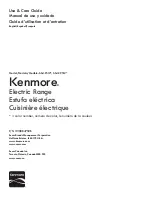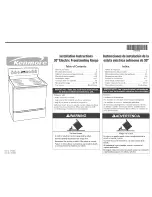
20
OVEN USE
About Your Oven
Odors and smoke are normal when the oven is used the first few
times, or when it is heavily soiled.
During oven use, the heating elements will not remain on, but will
cycle on and off throughout oven operation.
IMPORTANT: The health of some birds is extremely sensitive to
the fumes given off. Exposure to the fumes may result in death to
certain birds. Always move birds to another closed and well-
ventilated room.
The oven is equipped with a water filtration system. This system
is required for the use of the steam cooking functionality.
IMPORTANT: The oven will shut off the steam functions until the
filter is replaced.
The water filter needs to be changed occasionally. The life of the
filter will depend on factors such as the amount of steam cooking
done and the hardness of the water in your home. The oven has a
sensor to determine when the filter needs to be changed.
NOTE: It is normal to hear sounds during steam cooking cycles
related to the opening and closing of the water inlet valve and
water flowing into the steam system.
Aluminum Foil
IMPORTANT: To avoid permanent damage to the oven bottom
finish, do not line the oven bottom with any type of foil or liner.
■
For best cooking results, do not cover entire rack with foil
because air must be able to move freely.
■
To catch spills, place foil on rack below dish. Make sure foil is
at least ½" (1.3 cm) larger than the dish and that it is turned
up at the edges.
Bakeware
The bakeware material affects cooking results. Follow
manufacturer’s recommendations and use the bakeware size
recommended in the recipe. Use the following chart as a guide.
Positioning Racks and Bakeware
IMPORTANT: To avoid permanent damage to the porcelain
finish, do not place food or bakeware directly on the oven door or
bottom.
RACKS
■
Position racks before turning on the oven.
■
Do not position racks with bakeware on them.
■
Make sure racks are level.
To move a rack, pull it out to the stop position, raise the front
edge, then lift out. Use the following illustration and charts as a
guide.
Traditional Cooking
Convection Cooking
BAKEWARE/
RESULTS
RECOMMENDATIONS
Light colored
aluminum
■
Light golden crusts
■
Even browning
■
Use temperature and time
recommended in recipe.
Dark aluminum and
other bakeware with
dark, dull and/or
nonstick finish
■
Brown, crisp
crusts
■
May need to reduce baking
temperatures slightly.
■
Use suggested baking time.
■
For pies, breads and casseroles,
use temperature recommended in
recipe.
■
Place rack in center of oven.
Insulated cookie
sheets or baking
pans
■
Little or no bottom
browning
■
Place in the bottom third of oven.
■
May need to increase baking time.
Stainless steel
■
Light, golden
crusts
■
Uneven browning
■
May need to increase baking time.
Stoneware/Baking
stone
■
Crisp crusts
■
Follow manufacturer’s instructions.
Ovenproof
glassware, ceramic
glass or ceramic
■
Brown, crisp
crusts
■
May need to reduce baking
temperatures slightly.
FOOD
RACK POSITION
Large roasts, turkeys, angel food,
bundt cakes, quick breads, pies
1 or 2
Yeast breads, casseroles, meat and
poultry
2
Cookies, biscuits, muffins, cakes
1 and 4 or 2 and 4 or
3 for single rack baking
OVEN SETTING
NUMBER OF
RACKS USED
RACK POSITION(S)
Convection Bake
1
1, 2 or 3
Convection Bake
2
1 and 4 or 2 and 4
Convection Bake
3
1, 3 and 5
Convection Roast
1
1, 2 or 3
Convection Broil
1
3 or 4
BAKEWARE/
RESULTS
RECOMMENDATIONS
1
2
3
4
5
Содержание KDRU707
Страница 45: ...45 Notes ...
Страница 95: ...95 Notes ...
















































